Breeding
Breeding Philosophy
We believe that the focus of any sheep enterprise should be farm profitability in combination with a high quality of life and a product that exceeds consumer expectations.
Farm profitability is not about having the biggest sheep, the highest wool cut, or a pumped up overfed animal. It is about having a comprehensive look at all profit drivers.
We believe that sheep need to be able to survive and thrive on their own, with minimal chemical or feeding intervention. This is especially true in extensive areas such as exist in Queensland, where sheep are run on tens of thousands of acres and more intensive management is often impractical.
Breaking it down, we look to:
- Reduce micron
- Increase staple length
- Improve fleece structure and density
- Have good fleece cut
- Increase weaning and post weaning weight
- Limit adult weight
- Increase fertililty, ewe rearing ability
- Increase worm resistance
- Remove susceptibility to flystrike
- Eliminate structural faults
Key Profit Drivers
We think the key profit drivers are:
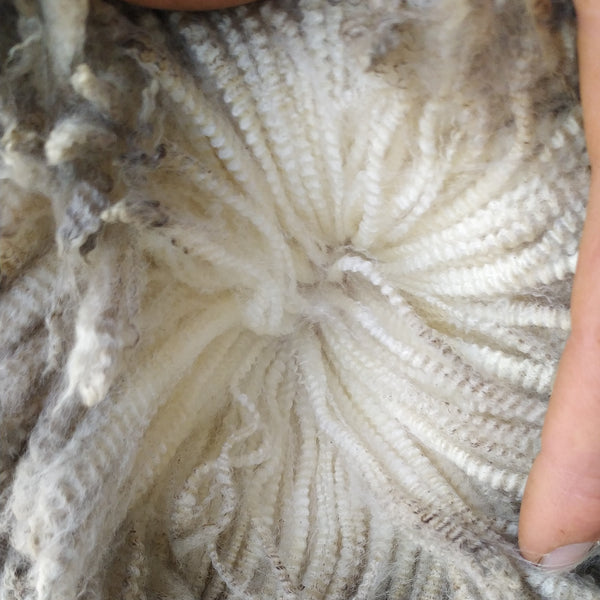
Quality wool
There are two parts to this. Obviously, higher quality wool fetches a premium in the market. Lower micron, higher yields, higher staple strengths and so on all add value.
Secondly though, quality wool is a key part of breeding sheep that are resistant to fly strike and fleece rot without mulesing. This saves money and time on chasing flies and jetting, as well as capturing the ever growing non-mulesing premium. Click to read more on eliminating mulesing.

Fertile sheep
Lamb prices continue to rise dramatically, so surplus lamb sales are a major profit driver. Another key consideration is that more lambs allows for faster genetic gain by allowing a higher percentage of lambs to be culled.
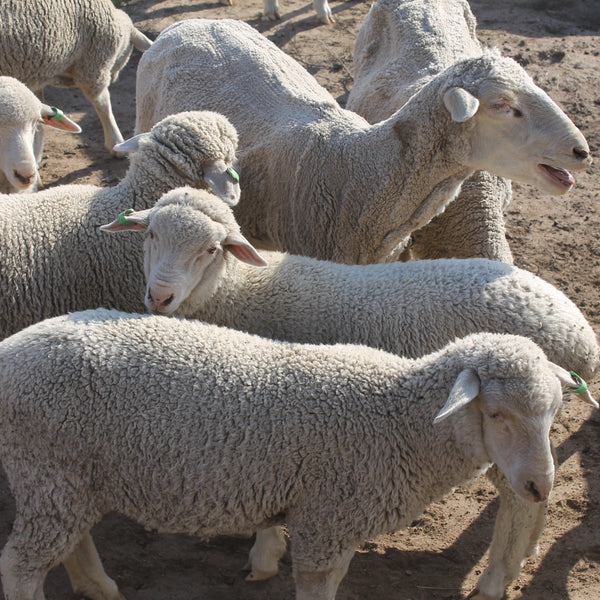
Early maturing lambs
Lambs that mature earlier have a good headstart to life and have better survival across their life. They will also reach sale weight at an earlier age, or can be sold at a heavier weight.
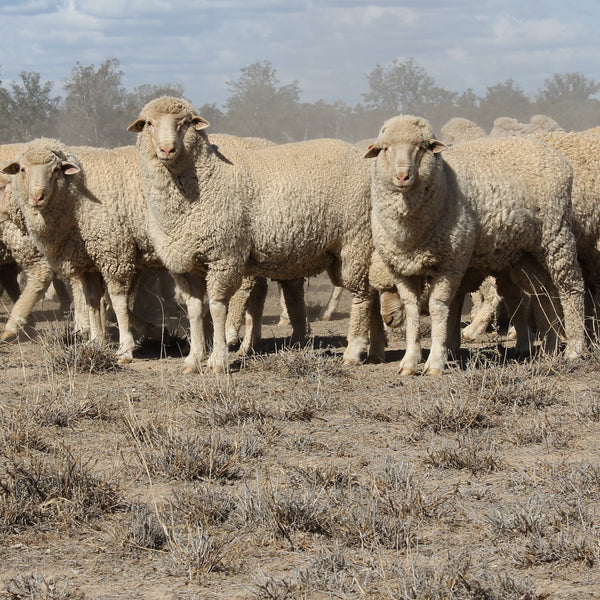
Efficient use of lower quality pastures
Not many people like feeding sheep, nor the extra costs that are incurred by doing so! Efficient forage use means that animals can put on condition in the good times to carry them through the tough times. Extra feeding is limited to severe droughts and production feeding at critical times like for lactating twin bearing ewes.

Continual genetic improvements
The average single born lamb from a mature ewe is going to be visually more appealing than a twin born lamb from a maiden. We use a combination of breeding values (ASBVs) and visual assessment to guarantee that it is the genetics, not environmental factors that we are classing on.
Wool that excites
When classing our sheep, we are looking for wool that is soft to touch and bright white with no colour. It must also have a long staple length, a deep, bold, horseshoe crimp and highly aligned fibres. Soft to handle wool is very important because it indicates that the wool fibres are fine, and very evenly sized. This results in a fleece that has better staple strength and superior processing qualities, with less waste (noil) in the manufacturing process.
Longer staple lengths is another thing we actively select for. Many of our younger sheep are now growing over 13mm of wool per month! Being able to move to 6 monthly shearing has many advantages. When we shifted our shearing from post joining in May to pre joining in February, we gained 10% extra lambs simply due to the benefit of extra condition on the ewes leading up to joining. Being able to shear before joining as well as prior to lambing means that benefit can be seen at both those critical stages.
There is something in our environment here at Rosedale that creates huge selection pressure on whiteness of wool. Over the years, we have often bought sheep that had bright wool when we bought them, but within a year they were yellow. We have often said that if we can breed white wool here, it will be white anywhere! Thus, the ability to maintain bright white wool is a very important trait for us
Sheep that thrive
The constitution and structure of an animal is of utmost importance to us. Before anything else, sheep need to be able to stand and walk well. We select animals with long, deep bodies and big hindquarters that are wide, square and deep in the twist. Rams need to have large scrotums. The sheep have wide, soft muzzles and long, soft ears.
The ability to maintain body condition in varying pasture conditions is also very important. We select animals that stay in good condition, have large eye muscle areas and good levels of fat cover.
Another key trait we select for is early maturing sheep. We believe that there is no point having overly large animals that require more feed to maintain their body weight. Instead, we are more concerned with how quickly they can reach their mature body weight. There are multiple benefits. Lambs are born at a healthy weight and very quickly gain weight over the first few weeks of life, causing them to be much more lively and resilient. Next, they will be reaching a sale weight quicker. Also, they will be more fertile and productive as a maiden or ewe lamb.
Possibly one of the biggest profit drivers is fertility. At Rosedale, any sheep that doesn't have a lamb each year doesn't get a second chance. The remaining ewes are proven breeders, and there are currently 10 year old ewes here that have had lambs (often 2) every year for their whole life.
Mulesing alternatives
Breeding away from mulesing is not only possible, it is easy and can be achieved within two generations with the genetics available today. Many producers might even find they are able to stop mulesing after a single cross!
We haven't mulesed since 2006, after changing breeding direction only 10 years earlier. When we finally took the leap and stopped mulesing, we had absolutely no issues.
There is no reason not to change. The research has been around for over 80 years showing that a sheep with looser, thinner, less wrinkly skin has wool follicles packed more densely. There is little (if any) reduction in wool growing potential. Additionally, a plainer sheep will always be in better condition and produce more lambs than a wrinkly one.
Don't unmulesed sheep cut less wool?
Not necessarily! With measurement and ASBVs, it is really quite easy to break the correlation between wrinkle and fleece weight. However, our lambing has increased by over 30% so now we cut a little less wool per ewe simply because we no longer have dry ewes!
Also keep in mind that unless you are running majority wethers, surplus lamb sales are a key profit driver. It is uneconomical to sacrifice fertility for a bit more wool. Sheep that have a wool cut of more than about 10% of body weight inevitably have a massive reduction in fertility and survivablity. In any case, you cut more wool overall with more lambs to shear!
How to breed a non mulesed sheep

Plainer bodies
It is obvious that a plainer sheep would be less prone to breech strike, as wrinkles create an ideal home for the flies to breed in. This has been achieved by measurement and selection for thin skin and high follicle density which results in a plain bodied sheep with no pin wrinkle.
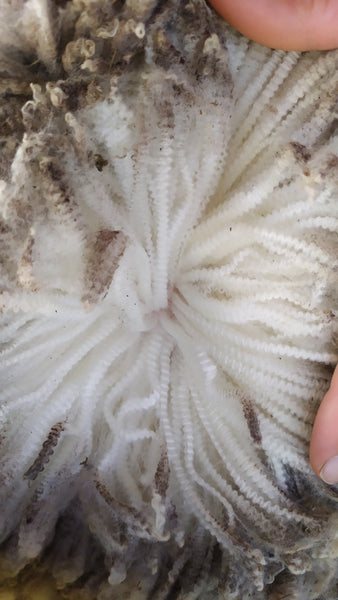
Wool quality
Selecting for high follicle density has the added advantage of producing large numbers of fine, evenly sized and well aligned fibres. This allows the wool to breathe and dry out quicker, also reducing the likelihood of fly strike (or fleece rot!) over the entire body.
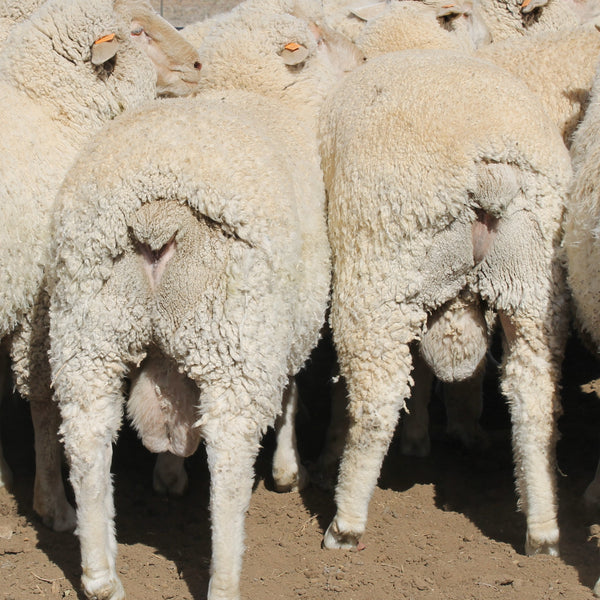
Bare and wrinkle free breeches
Our sheep also have naturally bare breeches, reducing the accumulation of dags and urine and making a less hospitable environment for flies.

Cull anything that gets blown
There are some sheep that are susceptible because of chemical compounds in their wool that attract flies. Other sheep are able to have a natural immunity to blowflies. This is not possible to pick up visually, so the sheep need a fly challenge to weed out the culls.
We don't jet our sheep, and besides a bit of clik for the lambs at marking time we don't use any other fly treatment. We only treat the occasional ewe blown on the crutch (less than 5% in substantial fly pressure years like 2021/22 summer). Then they are culled. Chasing flies is a mongrel job, but it's the only way to get rid of all susceptible sheep.
Measurement
We collect large amounts of data to enable us to make effective classing decisions and to generate estimated breeding values (ASBVs) thanks to Merino Select and Sheep Genetics. We collect the following data:
- Carcass traits. All our lambs get weighed every 3 months as a minimum. At 11 months, we also muscle scan, fat scan, condition score and collect a scrotal circumference on the rams. All ewes also get conditioned scored at least twice each year at joining and pregnancy scanning.
- Wool traits. At 10 months of age, all our lambs are shorn. We collect a host of data including fleece weights, micron, staple length, curvature, comfort factor and coefficient of variation among others.
- Reproductive traits. We pregnancy scan and mother up all our ewes and lambs.
- Health traits. We collect individual faecal worm egg counts and cull animals that are heavily affected by worms. On the rare occasion an animal gets flyblown, it is culled.
- Visual traits. Every lamb gets scored for structural traits, breech wrinkle, breech cover, wool character, wool colour, and dag score among others.
Management
Our flock is run for the most part under the same commercial conditions we operated under before buying Well Gully Poll Merino stud ewes and rams. We run our sheep in single large mobs to allow for accurate data collection to try and eliminate the environmental impacts and instead focus on their genetic potential.
We single sire mate all our ewes in mid April for 5-6 weeks, and start lambing in mid September. Outside of joining and lambing, the ewes are run together as a single mob under a planned grazing system. At pregnancy scanning, they are split into singles and multiples, with the multiples given preferential paddocks. They are then split into small mobs of mostly 100 or fewer just prior to lambing.
Soon after lamb marking, the ewes are again run all together. After weaning, the lambs are split into rams and ewes, and stay in those 2 mobs until we collect their wool data and carcass scanning data at 10 or 11 months of age. The lambs are run on our native and improved pastures, and spare cultivations over summer and autumn. In winter, we usually have an oats based mixed species forage crop to fatten and finish them on.
We are currently shearing at approximately 8 month intervals, but looking towards moving to a 6 monthly shearing.
